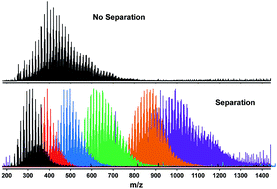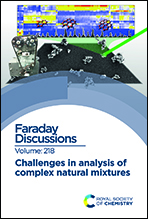Combating selective ionization in the high resolution mass spectral characterization of complex mixtures†
Abstract
Direct “dilute and shoot” mass spectral analysis of complex naturally-occurring mixtures has become the “standard” analysis in environmental and petrochemical science, as well as in many other areas of research. Despite recent advances in ionization methods, that approach still suffers several limitations for the comprehensive characterization of compositionally complex matrices. Foremost, the selective ionization of highly acidic (negative electrospray ionization ((−) ESI)) and/or basic (positive electrospray ionization ((+) ESI)) species limits the detection of weakly acidic/basic species, and similar issues (matrix effects) complicate atmospheric pressure photo-ionization (APPI)/atmospheric pressure chemical ionization (APCI) analyses. Furthermore, given the wide range of chemical functionalities and structural motifs in these compositionally complex mixtures, aggregation can similarly limit the observed species to a small (10–20%) mass fraction of the whole sample. Finally, irrespective of the ionization method, the mass analyzer must be capable of resolving tens-of-thousands of mass spectral peaks and provide the mass accuracy (typically 50–300 ppb mass measurement error) required for elemental composition assignment, and thus is generally limited to high-field Fourier transform ion cyclotron mass spectrometry (FT-ICR MS). Here, we describe three approaches to combat the above issues for (+) ESI, (−) ESI, and (+) APPI FT-ICR MS analysis of petroleum samples. Each approach relies on chromatographic fractionation to help reduce selective ionization discrimination and target either specific chemical functionalities (pyridinic and pyrrolic species (nitrogen) or carboxylic acids (oxygen)) or specific structural motifs (single aromatic core (island) or multi-core aromatics (archipelago)) known to be related to ionization efficiency. Each fractionation method yields a 2–10-fold increase in the compositional coverage, exposes species that are undetectable using direct “dilute and shoot” analysis, and provides coarse selectivity in chemical functionalities that can both increase the assignment confidence and optimize ionization conditions to maximize compositional coverage.

- This article is part of the themed collection: Challenges in analysis of complex natural mixtures


 Please wait while we load your content...
Please wait while we load your content...
